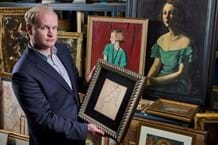As chronicled in David Stevenson’s recent work, The Beggar’s Benison Sex Clubs of Enlightenment Scotland, the club was founded in 1732 by John McNachtane, a minor Highland Chief who made a living as a crooked customs officer.
Nominally “a society for the collection of good songs, stories, jokes, and facetiae of all kinds”, instead members of the group met in the fishing village of Anstruther in Fife to perform public acts of sexual self-gratification, drink heavily and watch local girls dance naked.
At an annual meeting and dinner at Anstruther all members dined in their green silk sashes and wore ‘gold’ medals, the badge of the Order, which cost five guineas a time.
It has been said that before the organisation was disbanded in 1836 almost every nobleman in Scotland had at one time been balloted to be a member and many were amused to be enrolled in the “order of the jolly beggars”. Members included George IV, the Earl of Elgin, the Earl of Lauderdale and the Duke of Gordon.
Relics of the club are well recorded and include seals, medals, punch bowls and glasses. Far removed from the moral climate of the time, many are adorned with phallic symbols and the ‘blessing’ May prick nor purse never fail.
Because (rather than in spite of) its rather risqué past, there was substantial interest in this early 18th century silver mounted laburnum three-handled quaich offered by Edinburgh auctioneers Lyon and Turnbull on December 10.
Consigned by a Scottish vendor in whose family it had been for many generations, the 10in (24cm) diameter vessel included two inscriptions: Andrew Burnett Writer to the Signet and Margaret Mowat, his wife, September 21st 1731 and May the Beggars Benizon [sic] attend my owner.
As a piece of early 18th century silver it was perhaps worth around £1000, but with the link to the notorious Scottish sex club it bettered its £1500-2500 estimate, selling to a private buyer from England at £2700 (plus 17.5 per cent buyer’s premium).
Drinking with the Beggar’s Benison
One of the unforeseen consequences of the arrival of Enlightenment philosophy in Puritan Scotland was the creation of clubs and societies that encouraged exuberant and outrageous behaviour in their members. The best known is the Beggar’s Benison.




